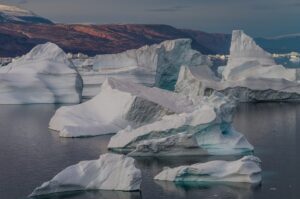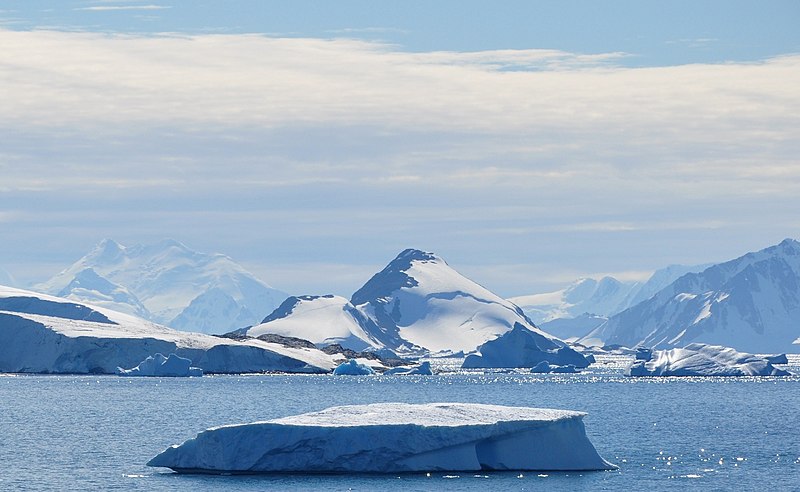Have you seen the ice in your refrigerators? Such a simple yet fascinating thing. Now imagine layers and layers of such ice-bound together. These layers of ice when formed naturally are called icebergs. These are enormous in size. Recently a massive iceberg has broken off the coast of Antarctica. What exactly has happened there? Why did the iceberg fall off? What are the effects of the massive iceberg break off in Antarctica? We will get to know everything in this article.
What is an Iceberg?

Icebergs are large pieces of ice that float on water bodies like ocean and lake. It is freshwater ice that has broken off from a glacier or ice shelf. Small parts of these icebergs which keep floating on the water surface are called growlers. The majority portion of an iceberg is under the water’s surface, and the small part we see is the tip of the iceberg.
According to the US Natural Oceanic and Atmospheric Association, to be called an Iceberg, a block of ice must be 4.8 metres in height above sea level. It should be at least 29 to 49 metres thick and should cover at least 500 square metres of area.
Icebergs can be seen in various sizes and shapes, from some small chunks of ice to large ice islands the size of a country. Smaller ones – growlers are often considered the more dangerous ones as they are a lot harder to spot. The North Atlantic Ocean and waters surrounding Antarctica are home to a large number of icebergs. Icebergs have led to some of the disastrous incidents in human history. One such major event of destruction was the 1912 Titanic incident. The largest cruise ship ever made was sunk in deep waters after it hit the tip of an iceberg.
How and where do icebergs form?
Icebergs are formed when large portions of ice break down from ice shelves, glacier or larger glacier. They move due to the ocean currents and often hit up against anything that comes in the way. The ice from glaciers breaks off due to the exposure to wind, tides and ocean currents which results in smaller chunks of ice. This is called ice calving which results in the formation of an iceberg from glaciers.
The Arctic and Antarctic regions are the largest producers of icebergs in the world. Antarctica produces 10 times more icebergs and also the largest ones. Coming from the ice caps, the icebergs in the Arctic are smaller and less in number.
Do you know why icebergs float on water?
For floating on a surface, the density of the substance must be less than the surface material. The iceberg is nearly 10% less dense than seawater. This enables it to float on the surface of the water.
What has happened in Antarctica recently?
Recently, a huge ice block has broken off from the coast of Western Antarctica has fallen into the Weddell Sea. With this, it has become the largest existing iceberg in the world. Researchers have named it A-76. It is the latest addition to the list of icebergs that have been released in this region which is very vulnerable to climate change. According to the US National Ice Centre, the iceberg A-76 was continuously monitored by scientists since May 13 when it began to tear apart from the Ronne Ice Shelf.
The iceberg is so huge in size that it is more than 40 times bigger than Paris and as much as 73 times bigger than Manhattan. It is even slightly larger than the Majorca island and is 170 kilometres long and 25 kilometres wide, with an area of 4,320 sq. kilometres. It is currently floating in the Weddell Sea. With this event, the previous record holder of the largest iceberg A-23A has moved to the second position with an area of 3880 sq. kilometres. Surprisingly, it has remained of the same size since 1986.
It was originally spotted by the British Antarctic Survey and its separation from the coast was confirmed by images from the Copernicus satellite. In 2017, the A-68 iceberg calved from the Larsen ice shelf which has warmed faster than other portion in Antarctica. It was humongous in size with an area of 5800 sq. kilometres and was 350 meters thick. It weighed a massive trillion tonnes which made it the largest iceberg ever seen.
Last year, the iceberg, last year when it was called A-68a, looked to collide with an island in the South Atlantic, which was home to thousands of penguins and seals and threatened their lives. But much to everyone’s relief, it broke off before it could harm any wildlife and vegetation.
What would happen to the A-76 iceberg now?
The iceberg will keep floating on the surface of the water. Scientists and researchers from all over the world will keep a keen eye on its movements, it’s melting as it floats away. This is to warn any ship that may be in the neighbouring regions, to assure no mishap occurs.
What experts believe regarding this iceberg breaking off from Antarctica?
Researchers have said that this periodic calving of ice shelves is a part of a natural cycle. Some of them have even hinted that this breaking up of the coast to form A-76 does not appear to be linked with climatic changes. Since the ice shelf was already floating on the surface of the water, the formation of the iceberg didn’t affect the sea levels. Whereas when glaciers fall off into the water, they have a huge impact on the sea levels.
Everywhere around the continent of Antarctica, the oceans have been warming continuously at a faster pace and this is making the ice drain into the water more quickly, which is eventually increasing the rate of sea-level rise.
Why are icebergs and glaciers melting?
There are several reasons why icebergs and glaciers are melting. Some of the prominent reasons are:
- Burning of fossil fuels The continuous burning of fossil fuels has increased the concentration of greenhouse gases which has warmed the atmosphere. This increasing temperature has led to more and more melting of glaciers and icebergs.
- Continuous global warming The average temperature of Earth is going up by one degree per Celsius since the beginning of the 19th century. This change is enough to cause more droughts, heat waves and cyclones. But Antarctica has heated up quite severely. It has warmed more than twice that much. Antarctica and Greenland have enough freshwater in frozen form to increase the sea level by 40 feet. This increase is capable of drowning major cities around the cities.
- Deforestation For every bad phenomenon going on the Earth, Deforestation is the reason for all of them. It has led to an increase in the concentration of carbon dioxide which resultantly has increased global warming.
Some interesting facts about stars!
- Some brave heart scientists even use these icebergs as the locations for their research.
- Approximately 90% of the total volume of an iceberg stays underwater.
- The term iceberg refers to a mountain of ice.
- Icebergs can travel huge distances as well. For example, the icebergs in the Arctic float around 2500 km to Bermuda.
- Since the Titanic tragedy, an international ice patrol was formed which tracks the movements and processes of icebergs and warns the required ones.
- At any moment in Antarctica, more than 100000 icebergs are continuously floating.
- The white colour of an iceberg signifies its young age. It turns blue or green as it ages.
So this was all about Icebergs! Everything about what happened in Antarctica! How a massive iceberg broke off into Antarctica!
Conclusion:
Icebergs are large portions of ice that break up from ice shelves or glaciers. They may be as small as few metres and may be as large as a country. The majority portion of an iceberg remains under the surface. Recently, a large portion of the Ronne Ice Shelf separated off into the water of Antarctica and was named A-76. It is the largest iceberg in the world with an area of 4320 sq. kilometres. It is around 40 times larger than Paris in size. Researchers say that it is part of a natural cycle. It is still floating on the surface and hence doesn’t impact the sea levels.
––––––––––––––
Recent Posts:
